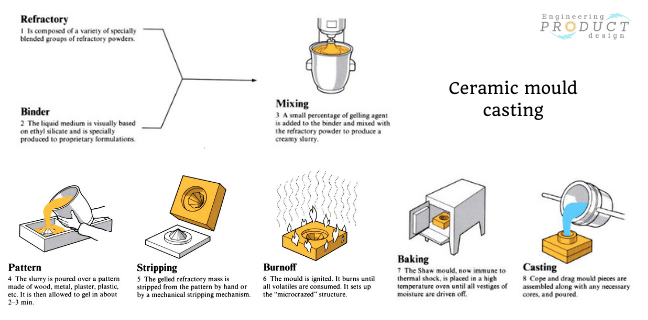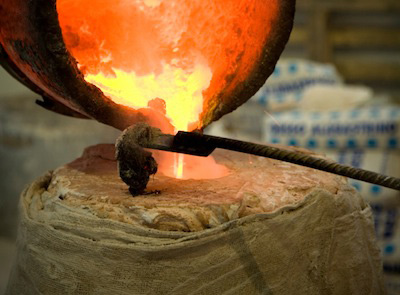A closer look at Aluminum Foundry processes and their efficient casting results
Wiki Article
Recognizing the Steel Castings Refine: A Comprehensive Guide for Beginners
The Metal Casting process is a basic technique in manufacturing that changes molten steel into strong forms. Newbies have to comprehend the different methods entailed, such as sand casting and die spreading. Understanding the materials, layout principles, and safety actions is similarly essential. Each aspect plays an important role in accomplishing successful outcomes. As one navigates these complexities, the concern of exactly how to enhance each step for boosted outcomes becomes increasingly pertinent.The Basics of Steel Casting
Metal Casting has evolved over centuries, its fundamental concepts continue to be essential and regular to the production procedure. At its core, Metal Casting entails the change of liquified metal into solid items through different strategies. The process begins with the creation of a mold, which specifies the form of the final item. When the mold and mildew is prepared, steel is heated to its melting point and poured into the dental caries. After cooling down, the steel strengthens, taking the form of the mold and mildew.There are several casting techniques, consisting of sand casting, investment casting, and die casting, each with unique advantages and applications. The option of method depends upon factors such as manufacturing volume, material kind, and wanted precision. When cast, the last item may undertake added procedures like machining or surface area therapy to achieve the needed surface and specifications. Recognizing these essentials is essential for anyone interested in the field of Metal Casting.

Recognizing Products Used in Steel Casting
Materials play a vital role in the Metal Casting procedure, influencing the end product's homes and performance. Different steels are made use of, including light weight aluminum, bronze, iron, and steel, each offering distinct qualities suited for certain applications. Aluminum is corrosion-resistant and lightweight, making it suitable for automobile parts. Iron, particularly cast iron, is favored for its superb wear resistance and resilience. Steel supplies high stamina and versatility, typically utilized in hefty equipment components. Bronze, recognized for its corrosion resistance and machinability, is frequently used in marine applications.Along with the steels, various casting materials, such as sand, plaster, and ceramic, are made use of to create molds. Sand casting, the most prevalent method, uses silica sand because of its thermal security and ability to form elaborate shapes. Plaster and ceramic molds use better information yet might call for more complex processes. The choice of materials straight influences the efficiency, price, and quality of the spreading procedure.
The Style Process: From Concept to Blueprint
The layout procedure in Metal Casting begins with the preliminary idea development, where ideas are generated and assessed. This is followed by the application of CAD modeling strategies, enabling accurate visualizations of the design. Finally, the plan completion steps guarantee that all specifications are accurately recorded for manufacturing.First Idea Advancement
First principle advancement marks a crucial stage in the Metal Casting procedure, where concepts transform into tangible designs. During this stage, designers team up with designers and stakeholders to brainstorm and fine-tune initial principles. They consider aspects such as capability, looks, and manufacturability, making certain that the layout fulfills the needed specifications and efficiency criteria. Illustrations and harsh drafts are created to visualize the ideas, permitting preliminary assessments of usefulness and cost-effectiveness. This stage likewise involves identifying products and prospective casting techniques that line up with the layout goals. Inevitably, preliminary concept advancement prepares for a detailed plan, leading the succeeding phases of the casting process and making sure an effective shift from concept to fact.CAD Modeling Techniques
Transforming ideas into specific designs, CAD modeling methods play a critical function in the Metal Casting procedure. These techniques utilize advanced software program to produce in-depth three-dimensional versions that precisely show the designated item. By utilizing tools such as parametric modeling, solid modeling, and surface modeling, developers can manipulate measurements and forms easily. CAD systems likewise facilitate simulation and analysis, enabling the identification of potential problems prior to production begins. This positive technique minimizes material waste and enhances the layout for manufacturability. Additionally, CAD models can be easily customized, allowing fast models based upon comments. Basically, CAD modeling functions as the backbone of the style process, bridging the void in between initial concepts and the eventual production-ready layouts.Blueprint Finalization Tips
Following the development of comprehensive CAD designs, the following stage entails plan completion, which is crucial in equating electronic layouts right into actionable plans for manufacturing. This process begins with evaluating the CAD versions for precision and compliance with requirements. When verified, the dimensions, resistances, and product specs are diligently described to ensure clarity. Incorporating comments and notes helps connect vital info concerning spreading processes, surface area coatings, and setting up requirements. The wrapped up plan undergoes an extensive approval procedure, typically involving partnership with engineers and manufacturing teams to resolve any type of possible problems. Nevertheless modifications are made and approvals obtained, the plan is officially launched, acting as the foundational record for the subsequent phases of Metal Casting, consisting of pattern making and mold design.The Steel Casting Methods Discussed

Metal Casting methods include a variety of approaches utilized to form molten steel into desired forms. These strategies vary according to the kind of material, complexity of the design, check these guys out and manufacturing quantity. Sand casting is one of one of the most typical methods, involving the creation of a mold and mildew from sand to hold the molten steel. Financial investment spreading, or lost-wax casting, allows for elaborate layouts by utilizing a wax pattern that is disappeared. Pass away casting employs high-pressure shot of molten steel right into a mold and mildew, ideal for automation. Other methods include long-term mold and mildew casting, which makes use of recyclable mold and mildews, and centrifugal casting, where rotational pressures assist in loading the mold and mildew. Each method has its benefits and applications, making it crucial for producers to pick the suitable approach based on their particular demands and needs. Recognizing these strategies is crucial for anybody associated with the Metal Casting process.
Finishing Procedures: Enhancing Your Casted Product

Ending up procedures play a necessary function in enhancing the top quality and look of casted products. Various surface area therapy techniques, such as sprucing up and finishing, are employed to enhance durability and aesthetics. Additionally, top quality assessment approaches guarantee that the end product satisfies specified requirements and performance needs.
Surface Treatment Methods
A selection of surface treatment strategies play a crucial function in improving the click site high quality and long life of casted products. These strategies include techniques such as shot blasting, brightening, and layer. Shot blasting properly eliminates surface imperfections, enhancing the visual and functional qualities of the spreading. Polishing gives a smooth coating, which is especially essential for attractive applications and parts requiring very little rubbing. Finishing strategies, such as electroplating or powder coating, deal added protection against rust and wear, guaranteeing sturdiness. Furthermore, surface area therapies can boost adhesion for subsequent procedures, such as painting or bonding. By employing these methods, suppliers can attain premium surface top quality, which is critical for the performance and lifespan of Metal Casting in different applications.High Quality Evaluation Techniques
Effective top quality assessment techniques are crucial for assuring the stability and efficiency of casted products after the finishing processes. Various techniques are used to analyze the top quality of Metal Casting, including aesthetic examination, dimensional checks, and non-destructive screening (NDT) Aesthetic examination permits the identification of surface area problems, while dimensional checks ensure that items satisfy specified resistances. NDT approaches, such as ultrasonic testing and radiographic assessment, supply deeper insights into interior honesty without harming the castings. Furthermore, mechanical testing, such as tensile and hardness examinations, examines material homes - Wisconsin Aluminum Foundry. By utilizing a combination of these methods, suppliers can enhance item top quality and integrity, inevitably bring about greater client fulfillment and decreased manufacturing expensesSafety Considerations in Metal Casting
While the Metal Casting process offers countless benefits, it additionally provides a variety of safety and security hazards that should be very carefully taken care of. Workers in casting facilities are exposed to heats, molten metals, and harmful materials, which can lead to severe injuries if correct precautions are not taken. Individual safety devices (PPE) such as heat-resistant gloves, deal with guards, and safety clothes is vital to lessen risks.Additionally, the existence of fumes and dust necessitates appropriate ventilation systems to guarantee air high quality - Aluminum Foundry. Normal training on safety and security procedures is crucial for all employees to acknowledge possible hazards and respond successfully. Emergency treatments ought to be developed, consisting of fire safety steps and emergency treatment schedule. Maintenance of equipment and proper handling of materials additionally add to a more secure working setting. By focusing on these safety considerations, Metal Casting procedures can shield their workforce and maintain effective production processes
Regularly Asked Concerns
What Are the Ecological Effects of Metal Casting?
Metal Casting can result in ecological impacts such as air and water air pollution, resource deficiency, and energy consumption. Additionally, improper waste management and emissions from factories add to ecological disturbances and wellness risks for close-by communities.Exactly how Do I Pick the Right Metal for Spreading?
To pick the right metal for spreading, one must take into consideration variables such as mechanical homes, corrosion resistance, thermal conductivity, and expense. Evaluating the desired application and environmental conditions is important for perfect choice.What Are the Common Defects in Metal Casting?
Usual issues in Metal Casting include porosity, shrinking, sand inclusion, and misruns. These problems often develop from inappropriate material choice, poor design, or problems in the spreading process, impacting the last item's top quality and efficiency.
Just How Can I Boost My Metal Casting Skills?
To enhance Metal Casting abilities, one must practice constantly, research study casting methods, examine previous tasks for defects, seek feedback from knowledgeable wheels, and continually experiment with different materials and techniques to improve effectiveness and understanding.What Is the Price of Beginning a Steel Casting Company?
Beginning a metal spreading business generally calls for a first investment of $5,000 to $50,000, depending on devices, products, and facility expenses. Variables like location and range can considerably affect general startup costs.The Metal Casting process is go an essential technique in manufacturing that transforms molten steel into solid forms. Beginners must grasp the numerous methods involved, such as sand spreading and pass away casting. There are numerous casting techniques, including sand casting, investment spreading, and pass away casting, each with unique benefits and applications. Financial investment casting, or lost-wax spreading, allows for complex styles by utilizing a wax pattern that is melted away. Various other approaches include long-term mold spreading, which utilizes recyclable molds, and centrifugal spreading, where rotational forces assist in filling up the mold.
Report this wiki page